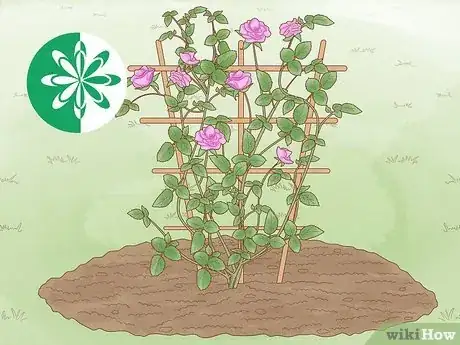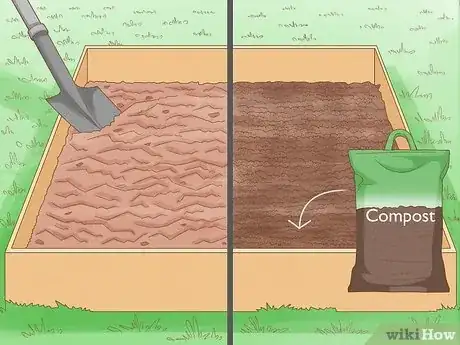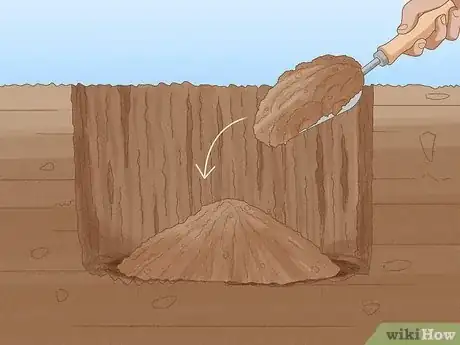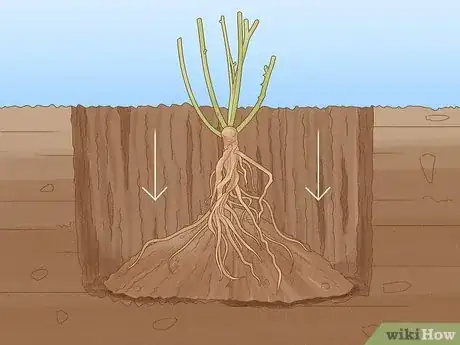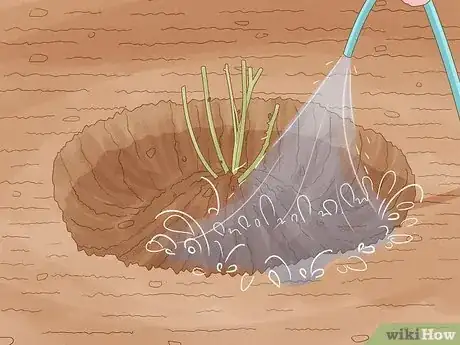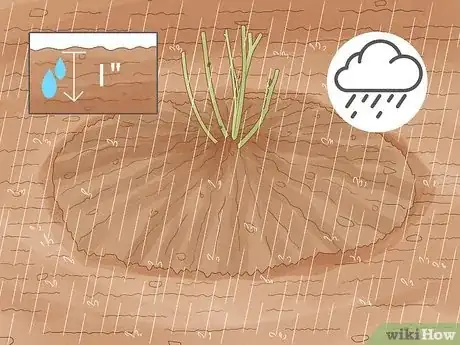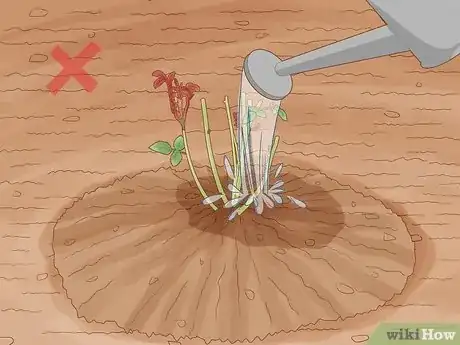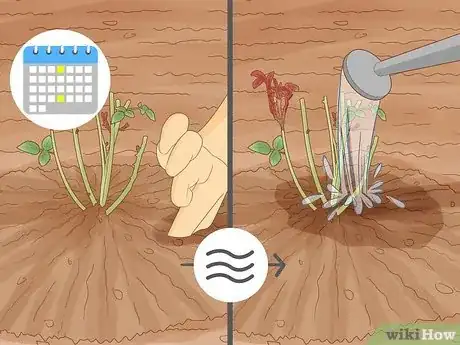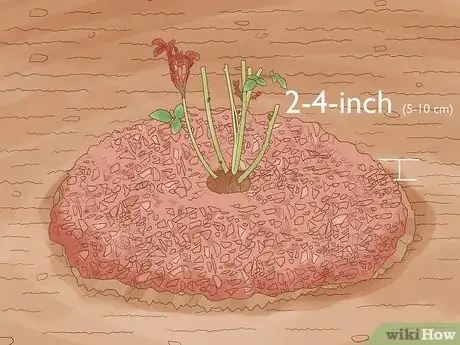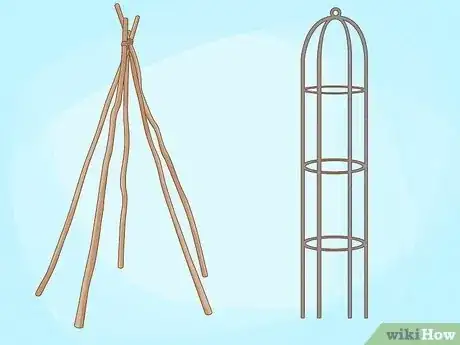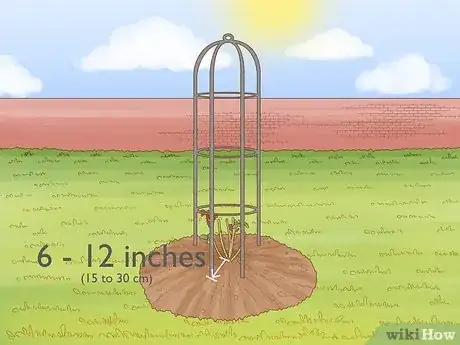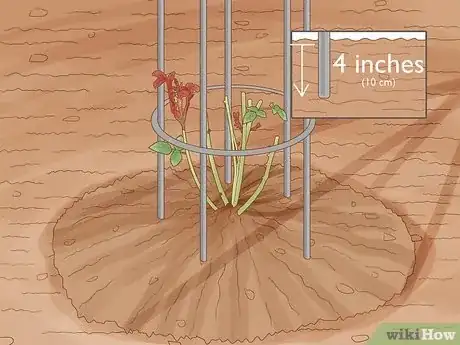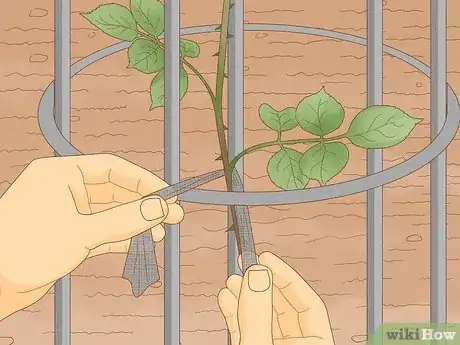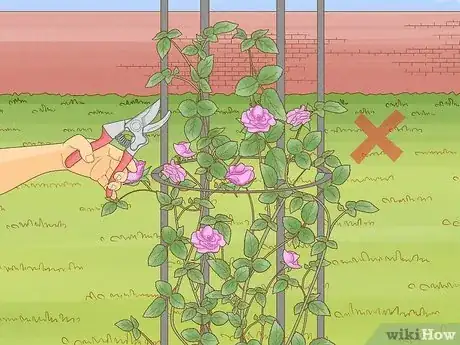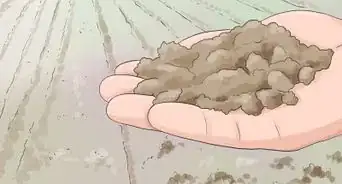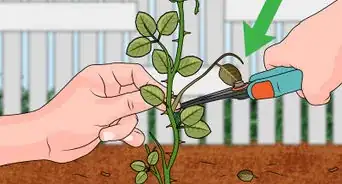This article was co-authored by Katie Gohmann. Katherine Gohmann is a Professional Gardener in Texas. She has been a home gardener and professional gardener since 2008.
wikiHow marks an article as reader-approved once it receives enough positive feedback. This article has 19 testimonials from our readers, earning it our reader-approved status.
This article has been viewed 292,728 times.
Climbing roses make an elegant, beautiful covering for nearly any horizontal or vertical structure. Technically speaking, climbing roses are not a specific rose breed. The term includes any rose variety that grows until a large, sprawling bush. Climbing roses are large shrubs that will grow out of control if left alone, but by training them along a trellis, you can get them to "climb" in an orderly fashion.
Steps
Planting the Rose
-
1Plant the roses in spring. Planting the climbing roses earlier in the season gives them ample opportunity to establish a sturdy root system before winter. You can technically plant them in the early fall, as well, but roses planted in the fall may not be as strong the following season.
-
2Choose an appropriate location. Roses generally prefer full sun, so the spot you plant them in should receive an average of at least six hours of sun per day. A spot that receives early morning sun from the east is generally better than one that gets hot afternoon sun from the west.[1]
- Choose a spot with plenty of space. Climbing roses tend to overtake the space that they grow in, so they should be positioned away from trees, shrubs, and other plants.
- Soil near walls and fences tends to be dry and low-quality. If you want to plant the rose within 1 foot (30 cm) of one, replace the soil with an even mix of quality topsoil and well-rotted compost or manure.[2]
Advertisement -
3Replace soil if previously used to grow roses. Roses suffer from "replant disease," meaning they may struggle or die if planted in soil where another rose plant grew.[3] Remove 6 inches (15 cm) of topsoil and replace it with soil from another part of your garden. For best results, mix the new soil generously with compost and allow to settle for 2–3 weeks.
- You may use the displaced topsoil to grow any plant besides roses.
-
4Add amendment to the soil. Roses need light, well-draining, nutrient-rich soil. Chop the soil in the plant bed up using a trowel or shovel and mix several handfuls of compost into the soil. Mix enough in that ⅓ to ½ of the plant bed consists of organic material.
- Skip this step if you already replaced the soil.
-
5Prepare the roots of a bare root rose. Climbing roses are often planted as bare root plants, without any container or ball of dirt. Before planting a bare root rose, soak in a bucket of lukewarm water for about an hour. Remove any leaves or hips from the stems, and prune long or damaged roots.
- Sanitize pruning shears before each use to prevent the spread of plant diseases.
-
6Dig a hole large enough for the roots to spread out in. A good rule of thumb is to make the hole about twice as wide as the actual plant. Usually, this means that the hole needs to be about 18 inches (46 cm) wide and 12 inches (31 cm) deep.
-
7Form a small mound in the middle of the hole. Scrape soil from inside the hole to form a small bump or hill.
- Some rose growers like to sprinkle rose fertilizer, bone meal, or other nutrients at the base of the hole. Do not use fertilizer on plants with young roots, as it can burn them. Other soil improvements should be based on the specific qualities of your soil.
-
8Place the rose plant in the hole. Sit the plant on the peak of the mound and carefully spread the roots out down the sides of the mound. (If your plant has a root ball, just spread out the roots growing around the outside.) Check the location of the graft union — the knot or ball where the root system was attached to the base of the trunk. Lay a tool handle flat from the edge of the hole to the trunk, and compare this with the level of the graft union:
- If you have dense or clay-heavy soil, plant the graft union about 1 inch (2.5 cm) above the soil surface to prevent rotting. Adjust the height of the mound as necessary.
- If you have light, loamy soil, plant the graft 1 inch (2.5 cm) below ground level.
-
9Water thoroughly. Fill the hole to the brim with water and let drain. Keep an eye on the water level. Continue to the next step as soon as it finishes draining, to prevent the roots drying out.
-
10Fill the hole with soil. Add soil back in the hole, until the roots are fully covered and the soil is level. As you fill, tamp down with your hands gently. Do not tamp with your feet or tools, as densely packed soil could harm the roots or interfere with the rose's growth.
- Pay special attention to tamping early on. Make sure there are no air pockets around the roots.
- Make sure the crown of the plant is above the soil level. The crown is the point on the trunk where the stems emerge.
Keeping Your Roses Moist
-
1Make sure that the roses get enough water. Roses require about 1" of rain each week, so make sure that you supplement their water needs if the rain isn't falling. Water them at the base of the plant near the soil.
-
2Avoid watering the leaves and blooms. While you can't control where the rainfall lands, if you add water to your plants make sure that you're avoiding buds and leaves. Otherwise, your plant may suffer diseases and rot, which can result from water. Instead, focus your watering on the roots.
-
3Check the soil 2-3 times a week. To make sure that your soil is moist but not soggy, check it 2-3 times a week. If it feels dry, add water. Allowing the roots to get too wet can harm your plant, so if your soil has been soggy, give it time to dry before adding more water.
-
4Add mulch to your soil. Place a 2-4-inch (5-10 cm) layer of mulch around your rose plants. The mulch will help keep your plants moist, and as a bonus it will also help protect against weed growth. During the winter, mulch can also help keep your roses from freezing.
Making the Rose Climb
-
1Choose the right climbing structure. Climbing roses tend to be fairly heavy, so you will need more than a pole to support them. Consider using a rose tower or teepee trellis, using the process described in the steps below. Alternatively, use existing structures:
- You may grow roses on a pergola or gazebo.
- Roses can grow up walls or fences, but the lack of air circulation can cause issues. Using a trellis or horizontal wires near the wall is recommended.
- Roses can be convinced to climb up a tree, but they will not cling to it on their own. Try tying sturdy string onto the lowest tree branch and anchoring it in the ground next to the rose.
-
2Position the trellis in the ground. Place the trellis about 6 to 12 inches (15 to 30 cm) away from the roses. If planting the roses near a wall or fence, do not lean the trellis directly against the structure. Instead, allow for at least 3 inches (7.5 cm) of space in between the trellis and the wall to give the roses plenty of air circulation.
-
3Install the trellis in the ground. You can often install the trellis simply by pushing its legs about 4 inches (10 cm) into the ground. If the soil is hard, dig a hole for each leg of the trellis instead. Pack soil back into the holes firmly to keep the trellis anchored.
-
4Attach the rose canes to the trellis. The smaller stems that carry the flowers are called rose canes. Attach these canes to the trellis as the rose bush grows tall enough to reach the bars. Choose the strongest canes and loosely tie them to the trellis using stretchy cloth, such as nylon or pantyhose.[4] Try to keep the canes spaced evenly apart, gently bending the new canes outward to cover the trellis.
-
5Avoid major pruning for several years. Other than removing dead branches, leave the rose shrub alone for two or three years. After that time, you can begin pruning side shoots down to two or three buds every winter, when the plant is dormant.
- When you are ready to prune your roses, you need to follow a specific process. Make a 45 degree cut about 1/4-inch (6 mm) above a leaf node. Be sure to angle your cut away from the leaf node so that any water on the plant runs away from the node instead of towards it.
Community Q&A
-
QuestionCan a climbing rose be planted in a very large pot?
 Community AnswerYes, but it's better to plant in a small pot first and then transfer it to the larger pot.
Community AnswerYes, but it's better to plant in a small pot first and then transfer it to the larger pot. -
QuestionHow do I start a new rose from the old plant?
 Community AnswerCut a live branch at a 45-degree angle and make sure the stem is showing green. Place it in a bucket of water; first put a little blood meal in it and stir it up, then drop the stem in it. Keep it in the sun until the roots are looking good and replant it in good soil.
Community AnswerCut a live branch at a 45-degree angle and make sure the stem is showing green. Place it in a bucket of water; first put a little blood meal in it and stir it up, then drop the stem in it. Keep it in the sun until the roots are looking good and replant it in good soil. -
QuestionWill a climbing rose be able to climb plastic lattice?
 Community AnswerClimbing roses don't actually climb -- they just grow really quickly and really tall. To make them into "climbing roses," you have to attach them to the lattice with something, such as twine.
Community AnswerClimbing roses don't actually climb -- they just grow really quickly and really tall. To make them into "climbing roses," you have to attach them to the lattice with something, such as twine.
Warnings
- If the rose is growing up a building's walls, be vigilant about pruning it back. It could cause structural damage or encourage rot and pests if it breaks into the gutters or roof space.⧼thumbs_response⧽
Things You’ll Need
- Climbing rose plant
- Compost
- Trowel or shovel
- Watering can or garden hose
- Trellis
References
- ↑ http://www.colostate.edu/Depts/CoopExt/4DMG/Flowers/Roses/climbers.htm
- ↑ http://www.express.co.uk/life-style/garden/457161/Alan-Titchmarsh-on-growing-plants-against-a-wall
- ↑ https://www.rhs.org.uk/advice/profile?PID=572
- ↑ http://www.garden.org/howtos/index.php?q=show&id=1281
- ↑ http://www.rirs.org/Introduction%20to%20Climbing%20Roses.htm
About This Article
To plant a climbing rose, choose a spot that gets at least 6 hours of sun per day and has plenty of space for the roses to spread out. Once you’ve picked your spot, chop up the soil with a trowel and mix in several handfuls of compost to give your roses the nutrients they will need. Dig a hole about twice as wide as your rose plant so its roots will have room to grow. Then, create a small mound of soil in the hole and sit your rose plant on top so its roots are laying on the sides of the mound. Fill the hole up to the brim with water and let it drain. Finally, fill the hole with soil so the roots are fully covered. For more tips from our Horticulture co-author, like how to care for your climbing rose as it grows, keep reading!
